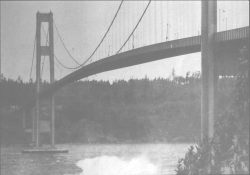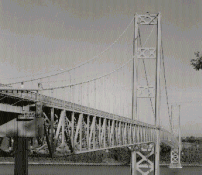Small oscillations and engineering implications
A good mathematical challenge is to understand how the unusual dynamics
identified in the introduction arise. Before we look at those problems
we will first look at a simpler problem, namely, how does the bridge behave
under small oscillations.
After the collapse of the bridge, an engineering analysis determined that the
section of the bridge formed by the roadway and the large thick supports on its
side, called stiffening-plate girders, did not absorb the turbulence of wind gusts;
at the same time, the narrow, two-lane roadway gave the span a high degree of
flexibility.
 Mathematically, modeling the bridge is very complicated if you account for the
position of the bridge as a function of space and time. However, if you are only
interested in the amplitude of the vertical motion and horizontal deflection, then
ordinary differential equations can be used to model the motion. This is what we
will do. The figure to the right schematically shows the vertical deflection
and the horizontal deflection. The simplest equation that is an appropriate model
of the bridge assumes that the supports of the bridge act like Hookes law springs.
Mathematically, modeling the bridge is very complicated if you account for the
position of the bridge as a function of space and time. However, if you are only
interested in the amplitude of the vertical motion and horizontal deflection, then
ordinary differential equations can be used to model the motion. This is what we
will do. The figure to the right schematically shows the vertical deflection
and the horizontal deflection. The simplest equation that is an appropriate model
of the bridge assumes that the supports of the bridge act like Hookes law springs.
The model uses Newton's second law and assumes the cables supporting the road
surface behave like Hooke's law springs. The ordinary differential equation
that models how the bridge oscillates torsionally is
x'' + c x' + k x = f(t)
where c>0 is the coefficient of viscous damping divided by the mass, k is the
spring constant of the cables divided by the mass, and f(t) is the force of
the bridge due to the wind. Notice that it has been assumed that the viscous
damping is like friction and its assumed to be proportional to x'.
The vertical displacement is also governed follows by a second order constant
coefficient linear differential equation, and gravity acts as a constant forcing
term.
The equation should look familiar to you. It also models the mass-spring-daphpot
systems, the pendulum for small swings, and electrical circuits. Your
assignment in this section of the project is to study the effects of c and
forcing for a given k. To get the Maple worksheet, click here
or to view a pdf version, click here.
The engineers recognized that in this equation, if c were large enough, the viscous
damping would prevent oscillations from growing very large. To implement this in
bridges, the engineers replaced the stiffening-plate girders with web trusses in future
bridges. Notice the difference in construction below, the old bridge is on the
left and the new bridge is on the right.
Go on to the next section
 Mathematically, modeling the bridge is very complicated if you account for the
position of the bridge as a function of space and time. However, if you are only
interested in the amplitude of the vertical motion and horizontal deflection, then
ordinary differential equations can be used to model the motion. This is what we
will do. The figure to the right schematically shows the vertical deflection
and the horizontal deflection. The simplest equation that is an appropriate model
of the bridge assumes that the supports of the bridge act like Hookes law springs.
Mathematically, modeling the bridge is very complicated if you account for the
position of the bridge as a function of space and time. However, if you are only
interested in the amplitude of the vertical motion and horizontal deflection, then
ordinary differential equations can be used to model the motion. This is what we
will do. The figure to the right schematically shows the vertical deflection
and the horizontal deflection. The simplest equation that is an appropriate model
of the bridge assumes that the supports of the bridge act like Hookes law springs.

